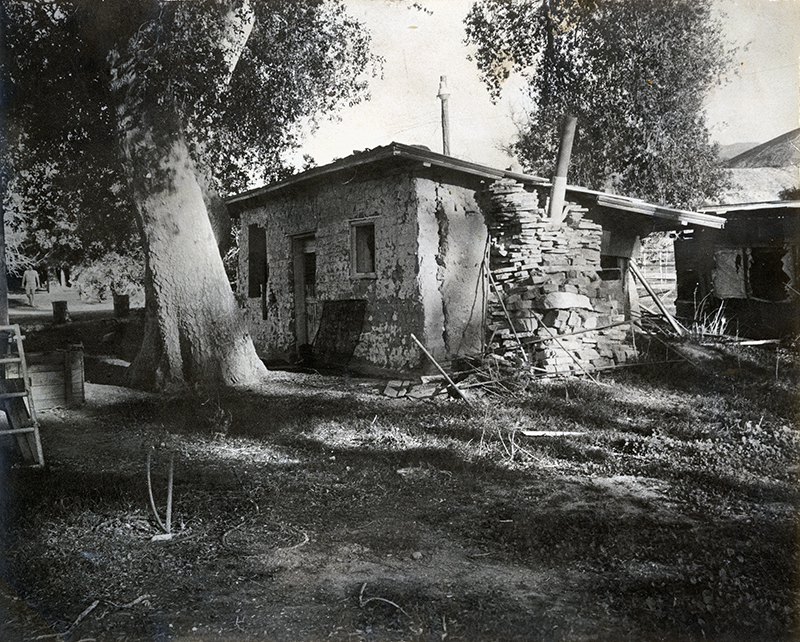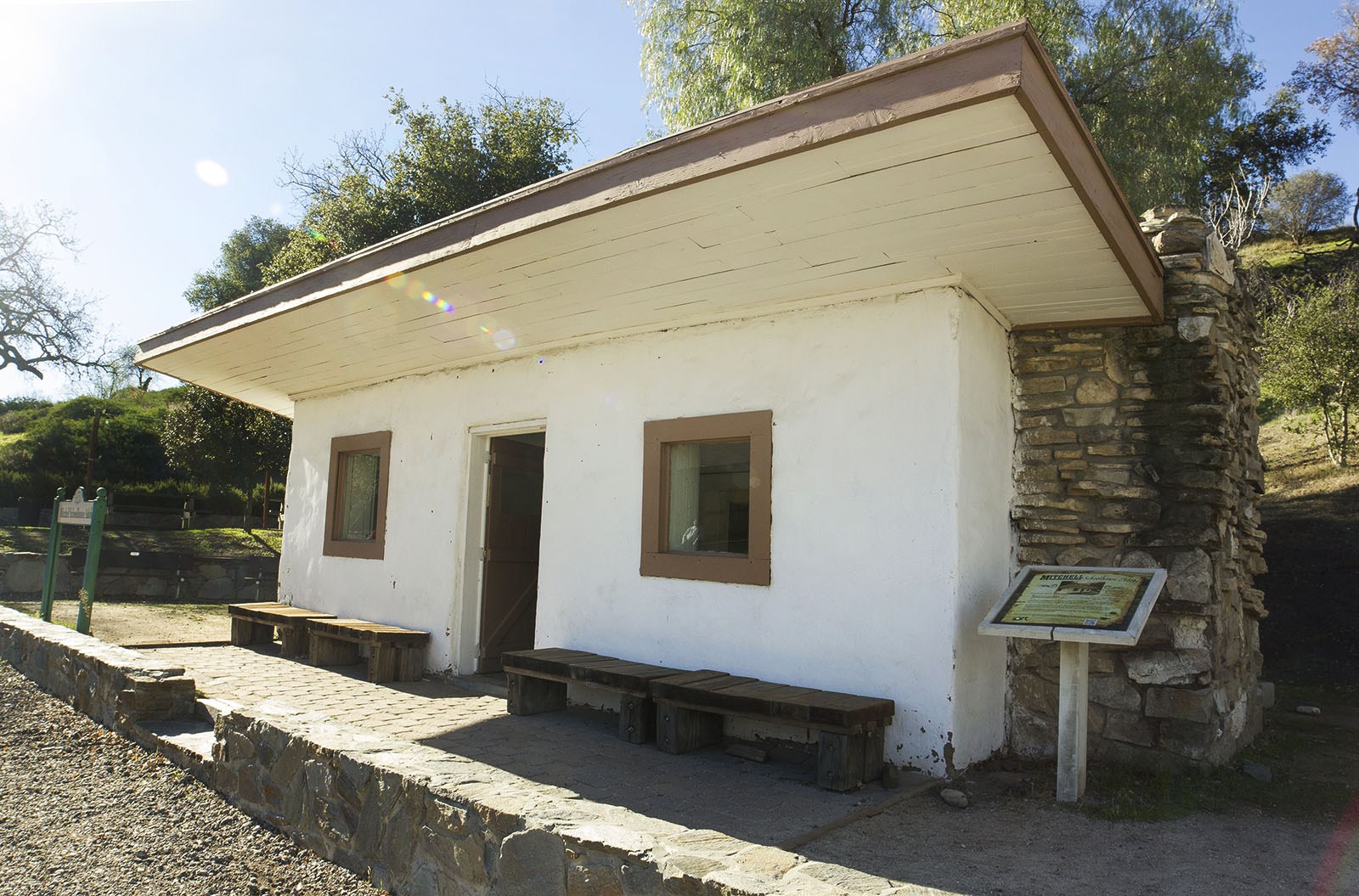Mitchell Adobe
Lost Canyon | Now at Heritage Junction

Click image to enlarge
| Download archival scan
Original matte print, 8x10 inches, showing the 1919 version of the Mitchell adobe near Lost Canyon and Sand Canyon roads, n.d. (Possibly 1930s-1940s; in any event, prior to 1960). The original Mitchell adobe (not this building) was erected about 1860 as the home of Thomas F. and Martha Mitchell. Beginning in 1872, after the neighboring Lang family arrived, the original Mitchell adobe became the first structure in the Santa Clarita Valley to be used as a school. In 1879, when the Sulphur Springs School District officially organized, lessons moved over to the Langs' hotel and spa. A "proper" schoolhouse came along in 1885 or 1886. In 1888, the Mitchells built themselves a new, 2-story frame house, and their original adobe fell into ruin. In 1919, Mitchell son-in-law Walter Murphy salvaged some of the original adobe bricks and used them to build a new adobe home nearby (seen here) for the ranch foreman. It was modified over the decades. Dial up the clock to 1986: Members of the Santa Clarita Valley Historical Society and the Sulphur Springs PTA — Judy Holland, Linda Lambourne, Tom Mason and his son Tony Mason, Cynthia Neal-Harris and her son Howard Harris — literally stood in front of a bulldozer to prevent the razing of the historic buildings. According to then-Society board member Cynthia Neal-Harris (pers. comm. 2020): "The bulldozer had made a swipe at the adobe roof corner; however, a swarm of bees turned the driver away, and he headed for the [1888] house. The property owner's lawyer offered us the adobe if we moved and let the [1888] house go. The sheriff helped us make that choice. We then had a Girl Scout troop come and paint the four sides [of the adobe] a different color, with paint donated by Tony [Maric] at the Newhall Paint store." Historical Society members then dismantled the adobe walls brick-by-brick, and Canyon Lumber transported them — an estimated 40,000 to 50,000 pounds' worth, according to Society records — to Heritage Junction in William S. Hart Park, where the 1919 version of the Mitchell adobe was recontructed. Neal-Harris adds: "New adobe [was] created for missing bricks where the bulldozer removed the top corner." The pending 5,000-home development that necessitated the demolition was never built. Nearly three decades later, in the 2010s, the property became part of the less impactful Vista Canyon Ranch mixed-use development. Among the notable differences between the adobe in the photograph and its current state at Heritage Junction: • In the photograph, the individual bricks are visible. At Heritage Junction, the walls have a smooth finish. • In the photograph, the roof extends over the flagstone chimney, from which a stovepipe protrudes. At Heritage Junction, the chimney extends above the roofline — consistent with this later (1960) photograph of the structure. No more stovepipe. • The roof at Heritage Junction extends much farther over the front door to protect the building from the elements.
About the Mitchell Adobe. Colonel Thomas Finley Mitchell, a veteran of the Mexican-American War, moved a miner's shack to Soledad and Sand Canyons in 1860 where he lived and headquartered his 160-acre ranch. After he married Martha Catherine Taylor in 1865, he constructed a large adobe, using parts of the miner's shack. After the Colonel had increased his holdings to 1,000 acres, Martha began the Sulphur Springs School in 1872, with classes being held regularly in the kitchen of the adobe. It moved to the Lang Hotel and Spa in 1879. The first students were from the Mitchell, Stewart and Lang families. In 1886, a regular school was built by John Lang and Sanford Lyon on land donated by the Mitchells.
The Mitchells built a new, 2-story wood-frame family home in 1888 and abandoned the old adobe, which fell into ruin. In 1919, the Mitchells' son-in-law, Walter Murphy, used the remaining adobe bricks to erect a home a short distance away for the ranch foreman. It later served as a guest house, apiary and tack room until it was threatened with demolition. Historical Society members stood in front of a bulldozer August 14, 1986, to prevent it from being razed. The property owner allowed them to salvage the adobe bricks, which were transported to Heritage Junction and reassembled. The rebuilt adobe was dedicated November 5, 1989. The upshot: Some of the straw and mud in the structure at Heritage Junction dates back to 1860 and bore silent witness to the Santa Clarita Valley's first formal education. The original 1860 adobe was 45x60 feet and made of clay dug from a layer deep in a hand-dug well. The roof was covered with either split redwood shake or a very thin cedar shake. It had a wooden floor constructed of light-colored wainscoting. As of 2012, the original Mitchell home site and the surrounding land are set to be developed into the mixed-use Vista Canyon Ranch project. Further reading: Tom Mitchell of the Soledad by Richard F. Mitchell, 2002. Tales of Lang and Soledad: The Story of an Adobe by A.B. Perkins, 1961. Story of Sulphur Springs School by Leon Worden, 1997.
HS9908: 9600 dpi jpeg from original photograph. SCV Historical Society collection.
|





